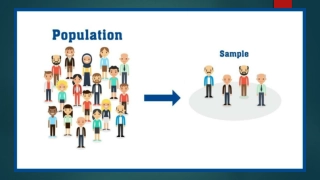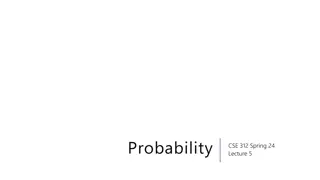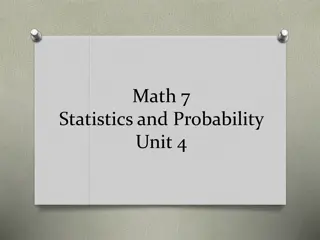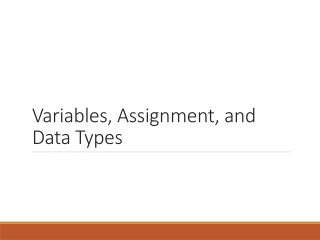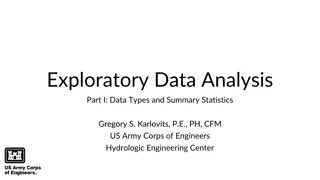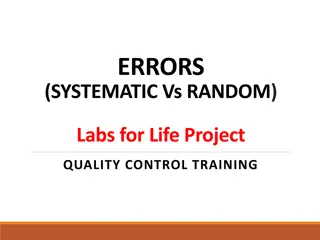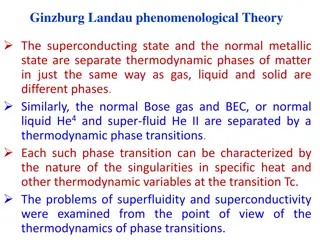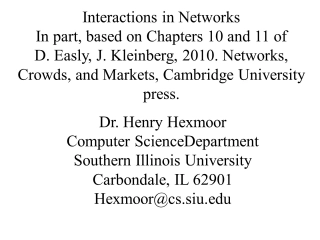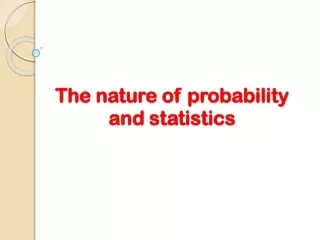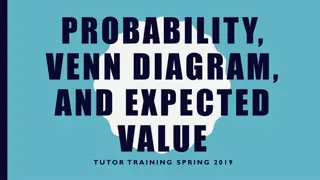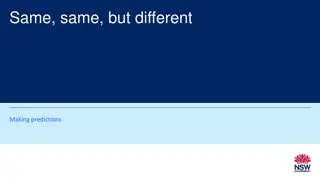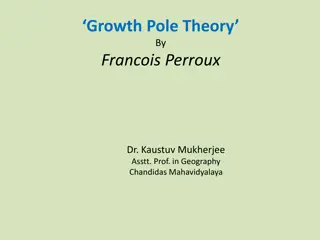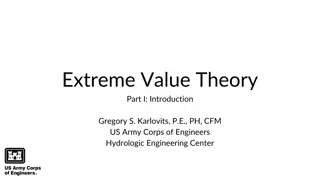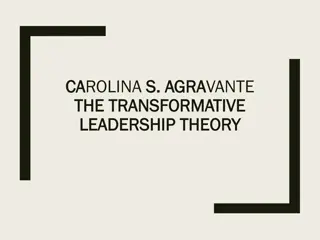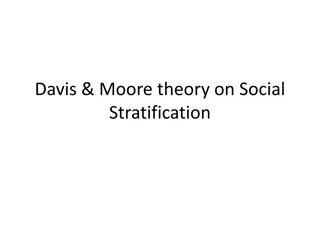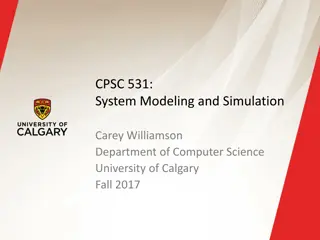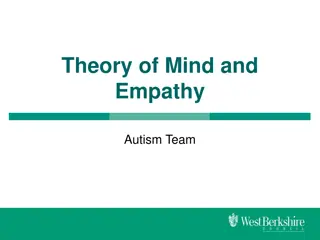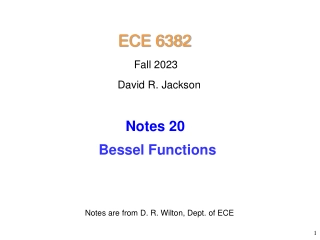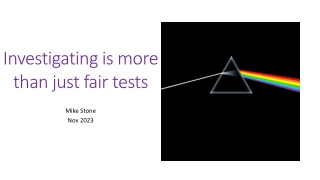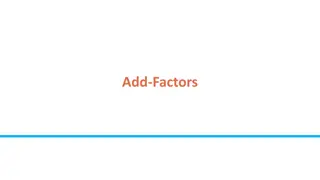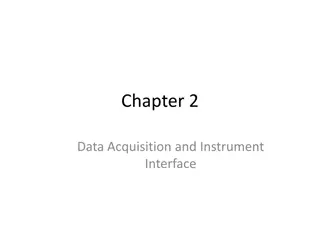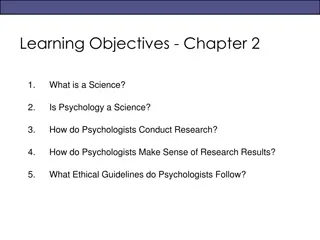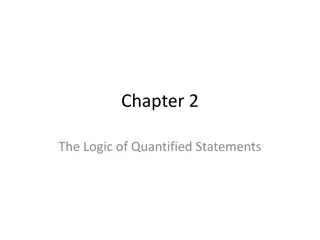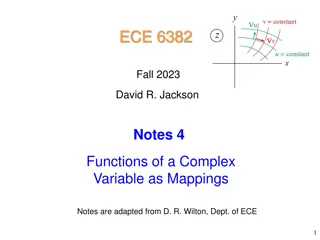Understanding Random Variables in Probability Theory
Exploring the concept of random variables in probability theory, including ways to define, calculate, and analyze them. Topics covered include infinite processes, methods for finding probabilities, and examples with dice rolls. Images and explanations help illustrate key concepts.
Understanding Random Variables in Probability Theory
PowerPoint presentation about 'Understanding Random Variables in Probability Theory'. This presentation describes the topic on Exploring the concept of random variables in probability theory, including ways to define, calculate, and analyze them. Topics covered include infinite processes, methods for finding probabilities, and examples with dice rolls. Images and explanations help illustrate key concepts.. Download this presentation absolutely free.
Presentation Transcript
Random Variables CSE 312 Spring 23 Lecture 10
Implicitly defining We ve often skipped an explicit definition of . Often | |is infinite, so we really couldn t write it out (even in principle). How would that happen? Flip a fair coin (independently each time) until you see your first tails. what is the probability that you see at least 3 heads?
An infinite process. is infinite. A sequential process is also going to be infinite But the tree is self-similar To know what the next step looks like, you only need to look back a finite number of steps. From every node, the children look identical (H with probability , continue pattern; T to a leaf with probability ) ? =1 ? =1 2 2 H ? = 1/2 ??|? =1 ??|? =1 2 2 H ?? = 1/4 ???|?? =1 ???|?? =1 2 2 H ??? = 1/8
Finding (at least 3 heads) Method 1: infinite sum. includes ??? for every ?. Every such outcome has probability 1/2?+1 What outcomes are in our event? 1 1 1/2=1 24 1/2?+1= ?=3 Infinite geometric series, where common ratio is between 1 and 1 has closed form first term 1 ratio 8
Finding (at least 3 heads) Method 2: Calculate the complement (at most 2 heads) = 1 2+1 4+1 8 1 2+1 4+1 =1 (at least 3 heads)= 1 8 8
Random Variable What s a random variable? Formally Random Variable ?: is a random variable ?(?) is the summary of the outcome ? Informally: A random variable is a way to summarize (numerical) information from your outcome. summarize the important
The sum of two dice EVENTS We could define ?2= sum is 2 ?3= sum is 3 ?12= sum is 12 RANDOM VARIABLE ?: ? is the sum of the two dice. And ask which event occurs ?
More random variables From one sample space, you can define many random variables. Roll a fair red die and a fair blue die Let ? be the value of the red die minus the blue die ? 4,2 = 2 Let ? be the sum of the values of the dice ? 4,2 = 6 Let ? be the maximum of the values ? 4,2 = 4
Notational Notes We will always use capital letters for random variables. It s common to use lower-case letters for the values they could take on. Formally Formally random variables are functions, so you d think we d write ? ?,?,? = 2 But we nearly never do. We just write ? = 2
Support The support (aka the range ) is the set of values ? can actually take. We called this the image in 311. ? (difference of red and blue) has support { 5, 4, 3, ,4,5} ? (sum) has support {2,3, ,12} What is the support of ? (max of the two dice)
Probability Mass Function Often we re interested in the event {?:?(?) = ?} Which is the event that ? = ?. We ll write (? = ?) to describe the probability of that event So ? = 2 = 1 36, ? = 7 =1 6 The function that tells you (? = ?)is the probability mass function We ll often write p?? (or occasionally ??(?)) for the pmf. probability mass function
Partition A random variable partitions . D2=1 D2=2 D2=3 D2=4 D2=5 D2=6 (1,1) (1,2) (1,3) (2,1) (2,2) (2,3) (3,1) (3,2) (3,3) (4,1) (4,2) (4,3) (5,1) (5,2) (5,3) (6,1) (6,2) (6,3) D1=1 D1=2 D1=3 D1=4 D1=5 D1=6 (1,4) (2,4) (3,4) (4,4) (5,4) (6,4) (1,5) (2,5) (3,5) (4,5) (5,5) (6,5) (1.6) (2,6) (3,6) (4,6) (5,6) (6,6) Let ? be the number of twos in rolling a (fair) red and blue die. ??0 = 25/36 ??1 = 10/36 ??2 = 1/36
Try It Yourself There are 20 balls, numbered 1,2, ,20 in an urn. You ll draw out a size-three subset. (i.e. without replacement) = {size three subsets of 1, ,20}, () is uniform measure. Let ? be the largest value among the three balls. If outcome is {4,2,10} then ? = 10. Write down the pmf of ? Fill out the poll everywhere so Robbie knows how long to explain Go to pollev.com/cse312
Try It Yourself There are 20 balls, numbered 1,2, ,20 in an urn. You ll draw out a size-three subset. (i.e. without replacement) Let ? be the largest value among the three balls. 3 if ? , 3 ? 20 ? 1 2 0 /20 ??? = otherwise Good check: if you sum up ??(?) do you get 1? Good check: is ??? 0 for all ?? Is it defined for all ??
Describing a Random Variable The most common way to describe a random variable is the PMF. But there s a second representation: The cumulative distribution function (CDF) gives the probability ? ? More formally, ?:? ? ? Often written ??? = (? ?) ??? = ?:? ???(?)
Try it yourself What is the CDF of ? where ? be the largest value among the three balls. (Drawing 3 of the 20 without replacement)
Try it yourself What is the CDF of ? where ? be the largest value among the three balls. (Drawing 3 of the 20 without replacement) 0 ? 3/20 1 if ? < 3 3 if 3 ? 20 otherwise ??? =
Try it yourself What is the CDF of ? where ? be the largest value among the three balls. (Drawing 3 of the 20 without replacement) 0 ? 3/20 1 if ? < 3 3 if 3 ? 20 otherwise ??? = Good checks: Is ?? = 1? If not, something is wrong. Is ??(?) increasing? If not something is wrong. Is ??(?) defined for all real number inputs? If not something is wrong.
Two descriptions PROBABILITY MASS FUNCTION Defined for all inputs. Usually has 0otherwise as an extra case. CUMULATIVE DISTRIBUTION FUNCTION Defined for all inputs. Often has 0otherwise and 1 otherwise extra cases Non-decreasing function ???? = 1 0 ??? 1 0 ??? 1 lim ? ??? = 0 lim ? ??? = 1 ?:? ???? = ??(?)
More Random Variable Practice Roll a fair die ? times. Let ? be the number of rolls that are 5? or 6?. What is the pmf? Don t try to write the CDF it s a mess Or try for a few minutes to realize it isn t nice.
More Random Variable Practice Roll a fair die ? times. Let ? be the number of rolls that are 5? or 6?. What s the probability of getting exactly ?5 s/6 s? Well we need to know which ? of the ?rolls are 5 s/6 s. And then multiply by the probability of getting exactly that outcome ? ? ? 1 3 2 3 ? ? 0 if ? ?,0 ? ? ??? = otherwise
More Practice: Infinite sequential processes
Infinite sequential process In volleyball, sets are played first team to Score 25 points Lead by at least 2 At the same time wins a set. Suppose a set is 23-23. Your team wins each point independently with probability ?. What is the probability your team wins the set?
Sequential Process ??? ???? ???? = ?2+ 2? 1 ? (??? ???? ????) 0 + - W 0 L + - W 0 L + -
Sequential Process ??? ???? ???? = ?2+ 2? 1 ? (??? ???? ????) 0 + - ? ? 2? ?2= ?2 ? 1 2? + ?2= ?2 W 0 L ?2 ? = ?2 2? + 1 + - W 0 L + -




